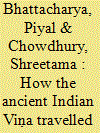| Srl | Item |
| 1 |
ID:
145924


|
|
|
|
|
| Summary/Abstract |
In Iran surrealism is spoken of by artists and critics as a living element in art, long after its popularity in Europe and North America has waned. This article explores key features of the work of one of the most prolific contemporary Iranian artists, Ali-Akbar Sadeghi. While Sadeghi says that he thinks of himself as a “surrealist,” his work is distinguished from many self-professed surrealists in Iran: whereas the latter are concerned with representing metaphysical, even mystical, meanings, Sadeghi sees his art as a kind of intellectual exercise, presenting a dramatic theater in which the viewer engages in epistemological interrogation. Though Sadeghi's paintings are full of apparent references to surrealist themes and tropes from the past, here it is argued that his work is not so much a storehouse of surrealist content as a series of puzzles for the viewer to solve.
|
|
|
|
|
|
|
|
|
|
|
|
|
|
|
|
| 2 |
ID:
186231


|
|
|
|
|
| Summary/Abstract |
Indian music before the 10th century AD was of a kind which we may today even find
difficult to understand, because we are no longer familiar with the nuances of that
tradition. The original forms of the musical instruments used during that time have
also virtually disappeared from mainstream India. But these instruments can be found
more or less in their original form outside India in South East Asia. These instruments
travelled out of India to these countries due to historical reasons. This essay brings
forth research that help us reconstruct the journey of the ancient Indian string
instruments (the Harp, the Tube Zither and the Stick Zither) from their original form
to their highly developed modern form, and in that process, demonstrates how India
was the fountainhead of foundational theories upon which classical string instruments
have developed in various cultures outside India, especially Myanmar and Cambodia.
|
|
|
|
|
|
|
|
|
|
|
|
|
|
|
|
| 3 |
ID:
132269


|
|
|
|
|
| Publication |
2014.
|
| Summary/Abstract |
This article explains the changes found in patas (cloth paintings) depicting Shatrunjaya, which were produced for Shvetambara Murtipujak Jains during the nineteenth century in Gujarat. These patas differed from earlier tirtha patas in that they were much larger and depicted Shatrunjaya as the central subject matter. They were also meticulous in depicting the topographical and architectural features of the site, and included Palitana, the adjacent town ruled by the Hindu Thakur. The emergence of the site as a centre for Jain pilgrimage, as well as changes in Jain perceptions of the site, led to these transformations
|
|
|
|
|
|
|
|
|
|
|
|
|
|
|
|